
 |
|
#21
|
||||
|
||||
|
I just recently bought an old/newish bass that was re-constructed around an old French Hawkes Top that was found in England with its original French Tuners. One way that I can personally confirm this is French is by the wood. It is the same wide and wavy grain often found on the Jacquet basses known as Silver Spruce. The Top was re-built around all for outer wings and also re-varnished in the process. Then, a fine Luthier in Hungary used Walnut that was cut into Back and Rib sets some 20 years ago re-made the bass modeled partially on the Hawkes pattern and even added the outer linings as found on the German-made Hawkes imports. The Neck with a short 3-string style British Peg-box was made new for the bass but he had an old Hungarian Head/Scroll lying around which he grafted to the top of the pegbox. Have a look;
 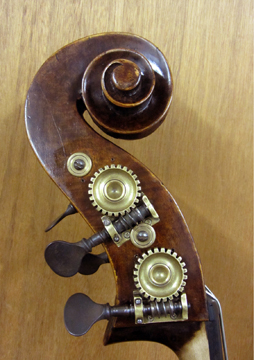  |
|
#22
|
||||
|
||||
|
|
|
#23
|
||||
|
||||
|
No, I don't think it was him but I can ask to make sure. The Old Hungarian bass I have was restored by him but this was another maker who possibly apprenticed with him. There are a few good makers/restorers there now but Rácz is the top guy in Hungary and possibly Eastern Europe.
|
|
#24
|
||||
|
||||
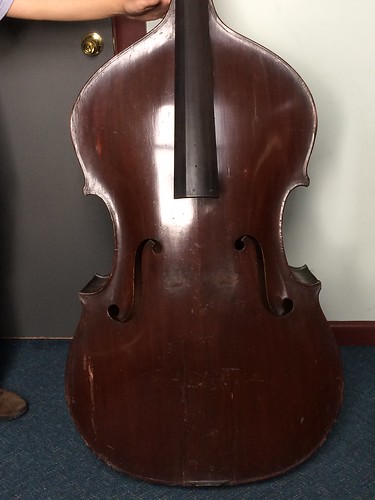 Received into workshop a nice "Hawkes Panormo" model roundback for restoration. 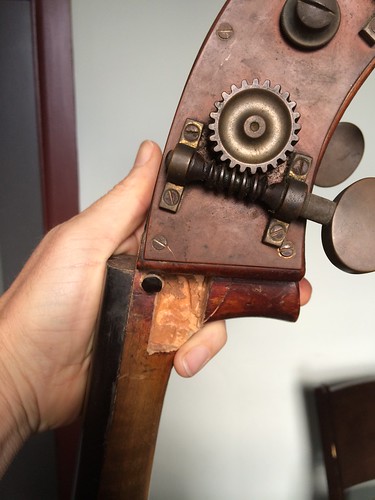 very nice smooth Baker style tuners   Has the H purfling, no outside linings, and a roundback.  It's in for scroll graft and badly needed top restoration. Back, ribs and blocks are in excellent condition.  The top is pretty funky. Lots of important cracks and a full edging required. And probably a new bassbar with cleats under!  It has some labels inside. But before showing these, knowing what we know in this thread so far, where do you reckon this one was made? (as if it matters to anyone but bass nerds) Last edited by Matthew Tucker; 07-30-2014 at 03:08 AM. |
|
#25
|
||||
|
||||
|
Matt, I had an 1894 Hawkes a couple of years ago. I don't know when the model names started like Professor, Concert and Panormo but from looking inside a couple of these I have learned something.
Please look inside the back of your bass here and tell me if there is a platform under the soundpost as part of the back itself coming from the c-bout area of the back to about a 5"x6" area. The 1894 Concert model had this platform carved out of the back. I brokered a 1921 'H' model Hawkes a few years ago and never looked at the inside as far as that feature goes. Recently when that bass was back for a visit, I looked inside and there it was, the same platform as on the older Concert model. I say Concert because it was a roundback and had outer linings. This is what we call the Concert model regardless if the name was in use then. The Hawkes & Son brand started around 1889 for these basses as far as I know. I had pass thru my shop or have seen a French Jacquet made Riverie & Hawkes, an 'F' model, an 'H' model and the Flat and Round back models with outer linings. I have seen claims to other basses being called French that were not and some basses called Hawkes of one style or another that bared no resemblance. It seems like some dealers just want a name attached to their bass for sale purposes. From that internal platform alone under the post, I think it is German in make. Possibly the 'H' and maybe earlier 'F' models were sold 'in the white' and completed in England but I don't see these as English or French basses. I have seen basses by Rubner and Dolling as well, made in Saxony c.1900 that were Hawkes 'looking' bass models. One Hawkes I saw had the name 'Joseph Rubner' inside of it marking the shop/maker that produced the bass for Hawkes. From 1889 thru the 1930s, we see several versions of each model of bass with a Hawkes label. I can only think that they contracted to whom ever would make basses for them. Possibly more than one shop at the same time in some periods. The basses by R&H from 1880-1889 (approx) where totally French model Jacquet family basses. I currently have a bass in restoration that has an English style scroll on a French model Jacquet-school bass and is original to the bass. This could be a R&H as well or just another Jacquet made for the English market that was sold to a different shop or brand. Contractors will make you what you want. Give the same plans to 10 different shops and you will get 10 different versions of them. I have seen this within the Hawkes brand. It is historic in English violin history, 'why make when you can import!' Also, the 'H' models had English Baker style gears. The outer lining German looking models (Concert/rnd bk and Professor/flt bk) have French Mirecourt Gears.. NOT German Gears. So, the Gears do not make the origin of the Bass. Confusing, but that's business..  |
|
#26
|
||||
|
||||
|
This has no platform under the soundpost.
|
|
#27
|
||||
|
||||
|
|
|
#28
|
||||
|
||||
|
See, my idea is correct. This looks to have a German Varnish or at least not the golden Varnish I have seen on other H or F models.
BUT, that seal that says Boosey & Hawkes is the latter company after Hawkes & Son. Founded in 1930.. This statement "Hawkes & Son (later Rivière & Hawkes),[2] a rival to Boosey & Company, was founded in 1865" Is actually incorrect according to my research. Hawkes & Son came after Riveire & Hawkes dissolved in 1889. Wiki pages are not 100% guaranteed to be accurate. Oh and Matt, thanks for the labels. This is a great find. It is the first 'H' model I have seen with a German label. Perhaps this one was sold too quick before it could be re-labeled as English. |
|
#29
|
||||
|
||||
|
Indeed.
This is a beautifully and neatly made bass with excellent wood. The maple has lovely flame under the rather sombre varnish. The two piece spruce top has very even and fine grain right across, if slightly wavy longways. The machines are ultra smooth. It has almost certainly been sold to a military or touring band or orchestra and its last repair was done in the Phillipines.  This last open top repair, although reasonably effective and neat, resulted in a very tightly glued edge and rather weak wood underneath, and a bit of casein and/or white glue in there too, and a fair quantity of putty and brown paint to "clean up" the edges and corners. The repair cleats are of some wood that i don't recognise. i think a casein glue has been used for these.   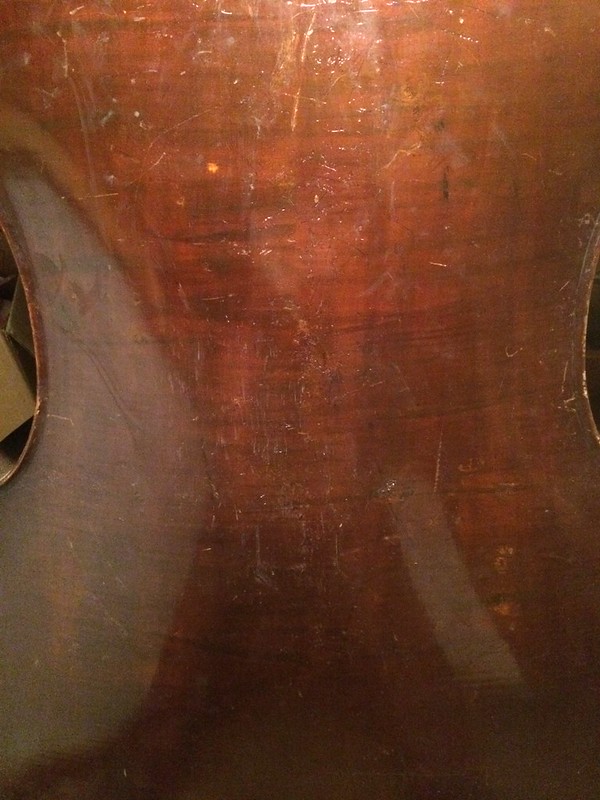 |
|
#30
|
||||
|
||||
|
This label is interesting.
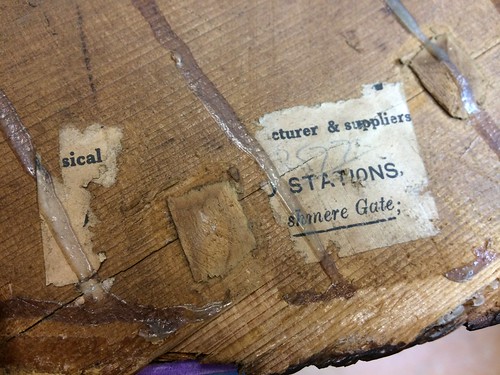 I think it is what's left of a music shop's address at Cashmere Gate - in New Delhi! Cashmere Gate was right near a major train station, and is now the name of a metro stop. Boosey and Hawkes would obviously have had outlets in India following the war, and in fact Besson (acquired by B&H) had a bugle factory in Delhi. So instruments would have been bought and sold through into asia from here as well. So it seems to me this bass has travelled quite a bit :-) |
|
#31
|
||||
|
||||
|
hi matthew, very interesting, thanks for showing.
|
|
#32
|
||||
|
||||
|
I have this bass here in my rack now and it looks very English all around. Label printed with Hawkes & Son, London 1921.
|
|
#33
|
||||
|
||||
|
Neck graft and mensure shortened?
|
|
#34
|
||||
|
||||
|
Yes, at it's last restoration. The bass came into the shop with a broken neck and needed work so it all got restored there at Arnold's. The owner then decided to sell the bass rather than pay for the restoration directly. I recommended the bass to a friend of mine and he bought the bass. Now, the bass is up for sale again. String length is 42" now. I don't know what it was before. The bass plays great as it is now.
|
|
#35
|
||||
|
||||
|
Quote:
The Bass has Pirastro Passione Starks on it now and what a thunderous sound it has.  |
|
#36
|
|||
|
|||
|
Thank you for this very detailed information about Hawkes basses. What you've collected here is great.
My first experience with Hawkes Panormo basses was at Juilliard. While a student there I received one to use from the Juilliard instrument collection. It looked much like the one pictured in the first posting in this thread. It had dark varnish, external rib linings, flat back, and the large tuning gears. Some wood was spliced into the upper back of this bass, so no H or F was visible. I worked with a bassist in the North Carolina Symphony who had two Hawkes Panormo basses: One had varnish that was orange in color, external rib linings, large tuning gears, and a round back. His other Hawkes Panormo did not have external rib linings, the varnish was light brown, round back, tuning gears were less large, and had very nice looking wood. The varnish and wood reminded me of a couple of instruments I'd seen from the Vuillaume shop. I do not recall an H or F on the upper backs of these basses. My latest view of a Hawkes Panormo bass was in a video demonstration from Lemur that was online during this year. Lemur was selling a Hawkes Panormo which sounded quite good over the internet. Hawkes basses are out there. -Dr. C. Last edited by John Cubbage; 07-18-2016 at 03:16 PM. Reason: Additional information & editing |
 |
| Currently Active Users Viewing This Thread: 1 (0 members and 1 guests) | |
|
|